Yamaha RX-A1080
Product Name: Yamaha RX-A1080
Product Description: 7.2 CH 4K AV Receiver
-
Design - 9.3/10
9.3/10
-
Audio Quality - 9.3/10
9.3/10
-
Inputs / Ports - 9.3/10
9.3/10
-
OS, Apps and Features - 9/10
9/10
-
Price / Quality - 9/10
9/10
Summary
Total Score
Pros
- Amazing audio performance
- Lots of features
- Great build quality
Cons
- No front HDMI
- Expensive for a 7.2 channels receiver
- No Google Assistant support
Cheapest Places to Buy :
*We are a reader-supported website. When you buy through links on our site, we may earn a small affiliate commission at no extra cost to you. Home Media Entertainment does not accept money for reviews.*
In 2018 Yamaha released their latest AVENTAGE lineup of receivers which is supposed to be the premium series of all the AV receivers they have on offer and for another year we see that they offer what is some key characteristics that set these receivers apart from the rest of their models.
With the 2018 lineup consisting of 5 different models Yamaha has managed to scale them accordingly in order to offer a lot of options for different budgets. A few months ago we had the pleasure to test one of these models and more specifically the RX-A880 which got very good marks across the board and prooved us that the AVENTAGE series is going strong for another year.
Today we have the pleasure to test another model belonging in the 2018 lineup as we take a look on the next model up the ladder with the RX-A1080. Being a 7.2 channels receiver as is the smaller RX-A880 that we tested some time ago the real question that many of you will have is if Yamaha has added enough features that would make this model worthwhile compared to it’s smaller brother and justify it’s higher price. So without any delay let’s start our Yamaha RX-A1080 review to find out.
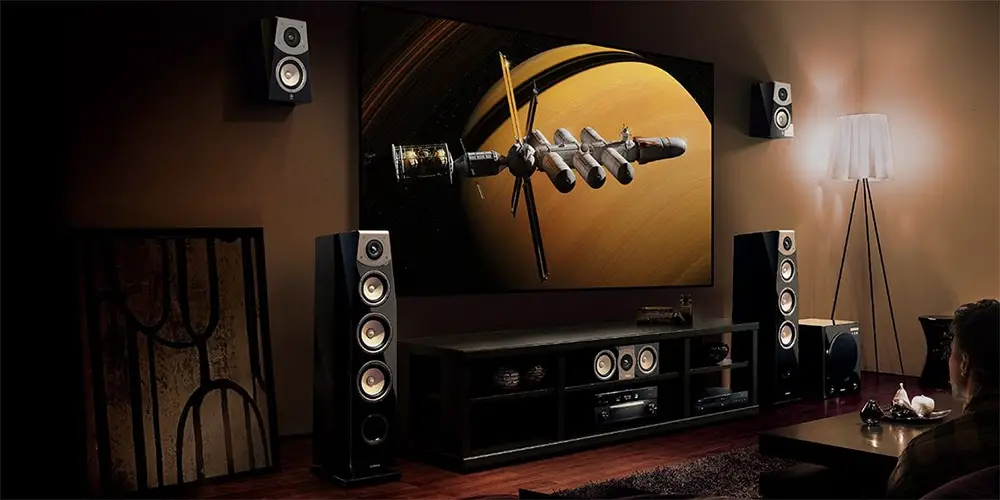
Design
With yearly releases we have seen that manufacturers of AV receivers tend to keep their designs year over year and Yamaha seems to be doing exactly the same with their AVENTAGE lineup for 2018. Design wise you will be hard to find any differences between this year’s model and the previous RX-A1070 one with the outer shell being exactly the same and the only thing that reveals the difference is the model number.
Looking the front of the receiver we find the 2 usual turning knobs for the volume on the right and the input selection on the left . The front panel has a distinct 2 part design with the upper part having a black gloss finish that houses the LED display in the middle with all the necessary visual information like volume, audio playback and input selection while on the far right there is a small Pure Direct button and on the far left the main power button.

The lower half of the receiver has an aluminum finish and we only get a hatch that hides all additional control buttons from plain sight. We love this design as this manages to keep the receiver clutter free, more dust free and provides a minimalist design that in our opinion is preferable in such audio equipment. After all you are not going to be using all these buttons very much so hiding them is the best idea.
Opening the hatch we find a wealth of control buttons including menu and settings navigation buttons, scenes and multi-zone controls as well as various other functions like AI, tuner and memory presets. Here we also find a few ports with a USB port, the YPAO microphone port, a PHONES jack as well as analogue stereo input provided. What we don’t like here is that there is no frontal HDMI port which is a huge convenience nowadays and with so many HDMI inputs provided at the back of the unit it’s puzzling that Yamaha opted not to include one at the front.

As we have seen in previous AVENTAGE models Yamaha has been putting extra attention to detail on how they construct these units in order to achieve the best quality possible. But here we also find the first main difference compared to it’s smaller brothers. Instead of using the Burr-Brown DACs that all lower AVENTAGE receivers have the RX-A1080 is the first unit in the series to go for a professional grade ESS Technology SABRE ES9007S 384 kHz / 32-bit Premier Audio DAC that offers much better signal-to-noise ratio and up to 120 dB of dynamic range.
But Yamaha has not stopped there as they have added a fifth foot with what they call Anti-Resonance Technology (A.R.T. Wedge) in order to reduce vibration while the rest of the feet also use an advanced design to provide better vibration resistance and enhanced strength.
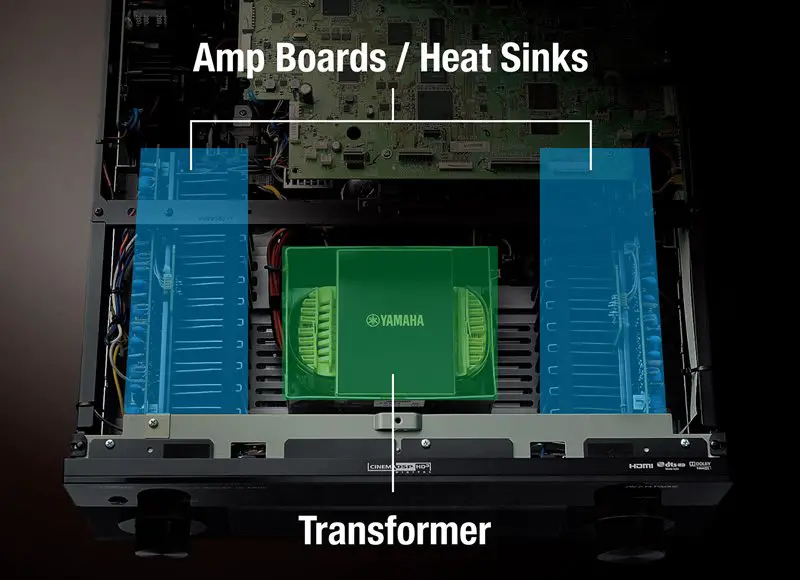
Also the use of high quality parts that are being used help achieve better audio performance while various technologies like high quality IC, independent pure power supply as well as low jitter PLL circuitry help optimize sound imaging. Yamaha makes sure to advertise all these every year as they are the foundation for the high quality that is characteristic of the AVENTAGE units.
The RX-A1080 is a little monster in size measuring 17-1/8” x 7-1/8” x 17-1/4” (435 x 182 x 439 mm) with the antennas down and weights 32.8 lbs (14.9 kg) and while we didn’t face any heating problems we would definitely recommend that you take extra care for this thing to be adequately ventilated just to be on the safe side.
As for the remote that comes with the receiver it’s very similar to the one we had seen in the RX-A880. Actually it is exactly the same with only one change, the inclusion of an AI button. Everything else is the same and so we would have to say that we feel the same way we did when we saw the RX-A880 one.

The remote is cluttered with buttons and while it definitely offers all functions needed when we live in an era where user interfaces with much better graphics is the common, to have so many buttons feels like a thing of the past. TV manufacturers are moving towards a more button-free environment with their smart remotes, why not the AV receiver manufacturers do the same?
Audio Quality
The Yamaha RX-A1080 is the last in the AVENTAGE series that supports 7.2 channels of built-in amplification as the next model, the RX-A2080, goes for a 9.2 channels setup. With the 7.2 channels we get here there are various different audio setups you can go for like 5.2 and 7.2 or if you want to take advantage of the Dolby Atmos and DTS:X immersion then you can try a 5.2.2 setup with 2 overhead speakers to cover the top acoustic layer. Unfortunately there is no support for expanding the channels to nine by adding an external amp so going for a 5.2.2 setup is the best this receiver can do.
The receiver offers 110 watts per channel (8 ohms, 20 Hz-20 kHz, 0.06% THD, 2-ch driven) making it perfectly fine for any kind of middle sized room. Our viewing area is not very big so we cannot test it’s behavior in a large space but the receiver had the ability to go pretty loud so we feel comfortable that the RX-A1080 will be able to handle most middle-sized spaces. There is also support for front speakers bi-amp connectivity in order to boost the sound quality of the front channels, something that many consider very important.

Another update we get in this model is the use of Cinema DSP HD3 while on the lower RX-A880 we only got Cinema DSP 3D. Cinema DSP HD3 is Yamaha’s revamped proprietary sound field creation technology that features new signal processing algorithms and three sets of high performance processors. What this basically does is to recreate certain spaces like concert halls or home theaters by utilizing specific algorithms and thus making you feel like you are in such an area.
It’s an interesting feature indeed and a few times we used it, it felt like it could produce the appropriate stage with enough realism but it is another audio processing feature and it’s up to the user if he likes the result or not. In our situation we preferred to keep this off and have the audio as pure as possible. In the RX-A1080 we get a total of 24 DSP programs to choose from.
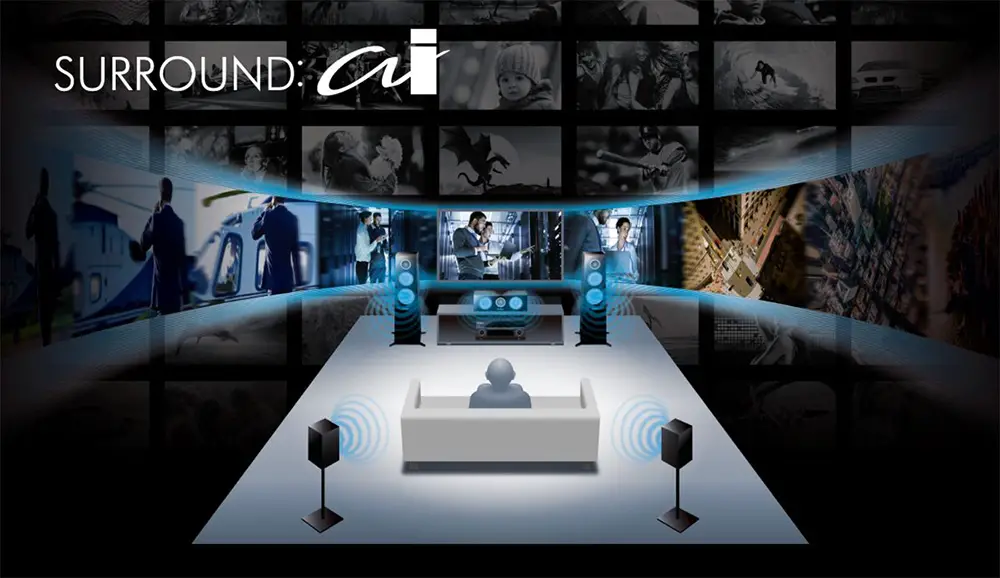
The RX-A1080 is the first model in this premium series that also offers Surround:AI which is a feature that is built-in the DSP and what it does is to optimize the surround effects in real time by analyzing each individual scene and focusing on distinct sound elements such as dialogue, background music, ambient sounds and sound effects. It’s a nice feature that some times can give nice results but ultimately it’s another digital processing feature that changes the original track. But we would recommend to give it a try as some people may like the results it gives and ultimately it’s another feature in the long catalog of features this receiver has.
As with all receivers that offer 7 channels we opted to go for a 5.1.2 audio setup with 1 subwoofer and 2 overhead speakers that are placed in the middle of our testing area. Our first title that we decided to test was the 4K UHD disc of Saving Private Ryan and what better scene to choose than the landing on Omaha beach. The receiver really gave an excellent performance from the first moment where we see the Allied soldiers on the boats with various subtle effects making the scene so much more alive. The marine engines rattling as the waves are splashing on the metal boats all the while German artillery is heard on the background.
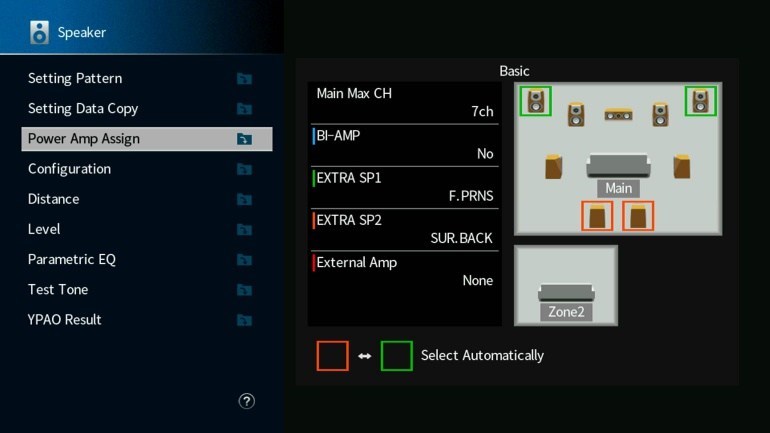
When the boats reach the beach and the doors open machine gun fire is ripping through the first rows of soldiers and you can feel the bullets passing right next to you with so much realism. When we are on the beach there is so much acoustic information to process that is breathtaking and the receiver manages to process everything with great accuracy and precision. The top layer add a bit more height to the soundstage as you can hear the artillery shells falling while the surround channels are busy with projectiles flying all over the place. An excellent Dolby Atmos track and the Yamaha RX-A1080 managed to reproduce it faithfully.
We also tried an all time favorite with the Blu-ray disc of Lord of the Rings: The Return of the King with it’s amazing DTS-HD Master Audio track which in our opinion is one of the finest tracks we have ever experienced in the aging Bluray format. As usual we skip to the scene where the Rohirim charge towards Sauron’s army and the combination of sound effects with Howard Shore’s orchestrated music gave us an amazing result that the Yamaha receiver made sure to deliver exactly as it should.
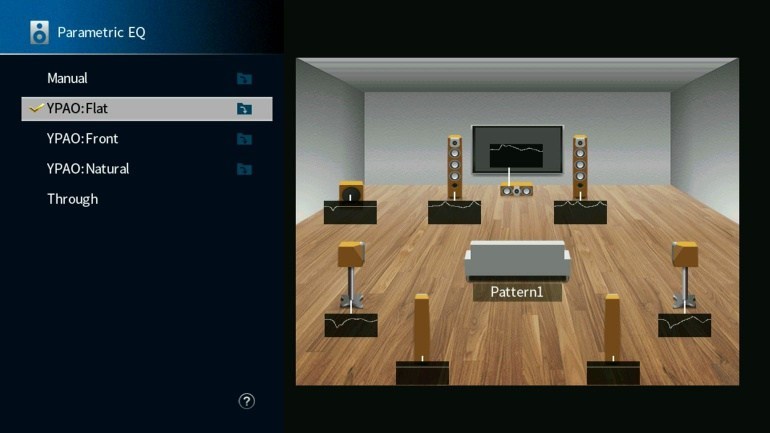
We could spend countless words describing this scene but we will just say that we may not have a Dolby Atmos or DTS:X track here but even like this the receiver managed to immerse us completely with it’s performance. Musical instruments were clearly distinguishable while all frequencies being delivered with enough punch and accuracy across the whole dynamic range.
And while the RX-A1080 is an excellent movie performer we could say that it was equally good during our music testing also. With precise delivery of the high frequencies, a balanced mid-range and a roaring low range the RX-A1080 felt like a maestro that was directing his orchestra with confidence and exceptional control. Just make sure to accompany this receiver with good quality speakers and it will blow you away by it’s capabilities.

The RX-A1080 can support music playback either online or through local network as well as from USB and supports the most usual of audio formats that include MP3, WMA, MPEG-4 AAC up to 48 kHz / 16-bit, ALAC up to 96 kHz / 24-bit, FLAC up to 192 kHz / 24-bit, WAV and AIFF up to 192 kHz / 32-bit and DSD up to 11.2 MHz.
Inputs / Ports
With the RX-A1080 sitting in the middle of the Aventage lineup we expected to find a good amount of ports included and in this regard the receiver does not disappoint. We already mentioned the 4 ports we get at the front with a USB (5V,1A), the YPAO microphone port, the PHONES jack and an analogue stereo input and with one big omission being in our opinion a frontal HDMI input.
At the back we find the 7 terminals for the main speaker channels plus two more terminals for zone 2/ bi-amp. The second most important connection of course are the HDMI ports and here we get a staggering 7 HDMI inputs with additional 3 HDMI outputs with one of them supporting ARC. All HDMI connections support HDCP 2.2 and 4K/60p (4:4:4), HDR Video including Dolby Vision and Hybrid Log-Gamma, and BT.2020 pass-through.
As for the rest we get 2 component inputs, 4 composite inputs, 7 analogue stereo inputs, 1 dedicated phono input, 3 coaxial and 3 optical audio inputs, zone 2 connections as well as 7.2 pre-out ports. There are also 2 12V trigger outputs, 1 remote in and 1 out, a RS-232C port, an Ethernet port for wired connection to the Internet as well as the usual FM and AM antennas connectors. At the top we find also 2 antenna connections for the WiFi and Bluetooth.
With such a high end model the most important ports are of course the HDMI ones and here the RX-A1080 does not disappoint. With 7 inputs and 3 outputs we cannot believe that someone would find them insufficient for any kind of home theater setup. There is also an abundance of legacy ports but we don’t believe that many will be using these as using the HDMI ones should be the preferable way to go. If there is one thing that we feel disappointed is that Yamaha has not included a front HDMI port and although we have already mentioned this in our opinion one would offer so much more practicality to a receiver like this. We can only hope Yamaha to rethink this for their future releases.
OS, Apps and Features
Feature wise the RX-A1080 is very similar to the RX-A880 with a couple of additions that we will talk about. Once again we find Yamaha’s proprietary calibration system called YPAO with R.S.C. (Reflected Sound Control) and Multi-Point Measurement that is able to correct audio reflections and also achieve the best sound possible at any of eight different listening positions. The difference in the 1080 model is that additionally we get Precision EQ that was not included in the 880 model and makes calibration even more advanced. After trying out the system we found it to offer very good results and for someone that don’t want to bother with manual calibrations it offers a great alternative.

The receiver also comes with virtual speakers technology that includes the Rear Virtual Presence Speaker and Virtual Surround Back systems. Each of these systems what they do is that through various algorithms they create sound that originate from positions that there are no physical speakers. In simple words they create virtual speakers and in essence you can have a 7.1 audio system for example when you only have 5.1 speakers present. These virtual systems may provide some added depth but they are never as good and precise as having real speakers. This is also very dependent on the audio track and how good it is mixed so we would suggest you to try this feature first to decide if you like the outcome or not.
A few other features that are included in this unit is 4K video upscaling, but this time this is not only available from HDMI input as it was in the 880 but also from analogue inputs, support for wireless surround speakers (MusicCast 20 or MusicCast 50) or wireless subwoofer (MusicCast SUB 100), it has built-in Wi-Fi (802.11b/g/n) as well as Bluetooth for wireless music streaming (SBC/AAC) and Bluetooth output for music streaming to headphones and also comes with an Eco mode that can save you up to 20% less power when in use.
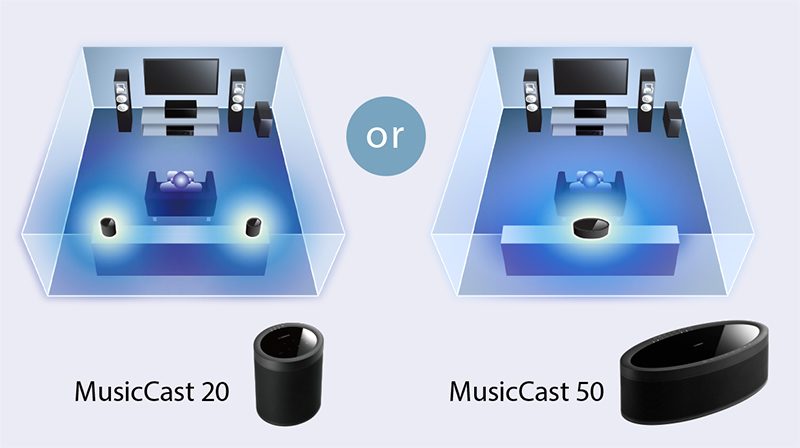
Voice control could not be missing from this unit as we find Amazon’s Alexa support for those that like a remote-free environment. We would like to see Google Assistant support also as many people opted to go with Google’s tech but unfortunately we don’t get that. Another option for control is by downloading the AV Controller App in your smartphone or tablet that Yamaha offers for free.
Another feature that has become pretty much a standard nowadays is Multi-zone Function (Zone2) and the Yamaha RX-A1080 makes well to offer such capabilities. MusicCast couldn’t also be missing and with it you can control any MusicCast enabled speakers you may have around your house. There is a separate MusicCast app you can download for Android or iOS in order to setup and control the various speakers in your home.
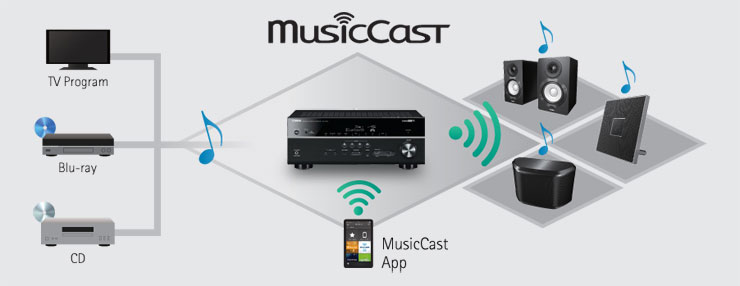
Apple’s Aiplay is also present and it lets you stream music from various Apple devices like Mac, iPod, iPhone or an iPad. Streaming is a must these days and even the lowest of receiver models come with a wide support so it was a given to find here support for the most known online and streaming services like Spotify, Napster, Pandora, SiriusXM, SiriusXM Music for Business, Tidal and Deezer. You also have access to internet radio (airable radio).
The Yamaha RX-A1080 comes fully packed with features and while a few are missing that are naturally kept for the 2 top dogs, some others are completely absent from the AVENTAGE series in general. But offering so many features means that consumers have a lot of options in their hands making this receiver an excellent choice.
![]()
Final Thoughts
Closing we have to admit that we really fell in love with the RX-A1080. It’s one fine piece of audio equipment and really offers the whole package for a 7.2 channels receiver. Build quality is excellent, audio performance is amazing while it comes fully packed with features and connections. So is there anything not to like?
Well there are a couple of minor disappointments like the omission of the front HDMI port and no Google Assistant support but these are not so big to lower it’s value much. But one thing that may make a lot of people rethink it is it’s price. The RX-A880 comes $300 cheaper and for this money the RX-A1080 offers a bit more power, a little more advanced YPAO system that includs Precision EQ, changes it’s DAC to an ESS SABRE one, it adds Cinema DSP HD3 and Surround:AI technology and offers an additional HDMI output for a total of three.
If these extras are worth the extra $300 is up to the consumer and the actual needs every single one has as some of these may be important to some making this extra cost worth it while for others these are unimportant and thus the RX-A880 may be a better option. But leaving comparisons out of the picture the Yamaha RX-A1080 is one hell of a receiver that is almost as good as a 7.2 channels receiver can get. If this is the maximum speakers you need then this receiver should definitely be on your short list for consideration.
For more reviews you can check our dedicated 7 channels 4K AV Receiver reviews list or even look at our Product Reviews Table where you can find the brand and specific product you are looking for.
Cheapest Places to Buy :
*We are a reader-supported website. When you buy through links on our site, we may earn a small affiliate commission at no extra cost to you. Home Media Entertainment does not accept money for reviews.*
Specifications
-
7-channel powerful surround sound110 W per channel (8 ohms, 20 Hz-20 kHz, 0.06% THD, 2-ch driven)135 W per channel (8 ohms, 1 kHz, 0.9% THD, 2-ch driven)170 W per channel (8 ohms, 1 kHz, 10% THD, 1-ch driven)
- Dolby Atmos and DTS:X with CINEMA DSP HD3
- Surround:AI automatically optimizes the surround effect in real time
- Enhanced CINEMA DSP program (total 24 DSP programs)
- Virtual Presence Speaker function for CINEMA DSP HD3 surround without front presence speakers
- Virtual Surround Back Speaker for playing 7.1-channel content with a 5.1-channel system
- YPAO – R.S.C. sound optimization with precision EQ calculation with multipoint measurement
- Professional grade ESS 384 kHz / 32-bit SABRE DAC (ES9007S)
- High-resolution Music Enhancer further heightens musicality from the original content
- Compressed Music Enhancer for Bluetooth
- Phono input for vinyl playback
- Latest HDMI (7 in / 3 out) with 4K Ultra HD Full Support (4K / 60p [4:4:4]), HDR video, Hybrid Log-Gamma and Dolby Vision Compatibility and BT.2020 pass-through
- 4K video upscaling from analog and HDMI input
- Yamaha original video processing that optimizes processing for each type of video content
— Motion-adaptive and edge-adaptive deinterlacing
— Multicadence (including 3-2 pull-down) detection
— Resolution enhancement (detail and edge enhancement) -
MusicCast for audio enjoyment in every room with ability to add MusicCast Surround speaker(s) (MusicCast 20 or MusicCast 50) and wireless subwoofer (MusicCast SUB 100)
-
Amazon Alexa voice control compatibility
- Wi-Fi Built-in (802.11b/g/n) and Bluetooth support
- AirPlay allows music streaming from Mac, PC, iPod, iPhone, iPad
-
AV Controller app for operating various functions from iOS or Android smartphones and tablets
-
Access to: Internet Radio (airable radio): MP3, WMA Streaming Services (Spotify, Napster, Pandora, SiriusXM, SiriusXM Music for Business, Tidal, Deezer). Music files on PC / MP3 / WMA / MPEG-4 AAC: up to 48 kHz / 16-bit, ALAC: up to 96 kHz / 24-bit, FLAC: up to 192 kHz / 24 bit, WAV / AIFF: up to 192 kHz / 32-bit, DSD: up to 11.2 MHz
- Pre out terminal for Zone 2 with volume control
- Advanced GUI on-screen display with HD capability
- ECO mode operation

I have owned several Yamaha receivers over the years and never have I been disappointed with the performance of any of them. This Yamaha RX-A1080 model, with the 7.2 ch and 4k AV receiver seems like a very good deal for someone that is serious about getting quality sounds and video for their entertainment center.
The few cons that you mention are not major ones for me personally, and the power it offers is just a tremendous upgrade from the lower end models you compare it with. Although the price is steep, as with other electronics, I have found that you get more when you pay more.
It looks great too, the footprint is not that large, and as you say it will fill a medium-sized room with rich sounds and effects easily. The 7.2 channels are enough for what I have currently, and I have no plans on growing my speaker inventory, so this receiver is one that I will probably upgrade to from the outdated model I am using now.
This is a useful and thorough review of the A1080 and I came away impressed with what it can do based on everything that you covered. Thanks for taking the time to do this review right. You have sold me!
Hello Dave. I am glad you found our review helpful. If you need any other help let me know.
Dave..
Did you manage to get this unit!? If so please give us a little review. Also why did you not tell us what equipment you had when you wrote your comment?!
I was ready to get the v685…but maybe add 500 euros and get this??
@Dave sweney
i think you might help me here….can you please tell me what were your previous yamaha AVR’s ?!
i am very interested in the A1080 BUT….most people i met on forums (some experts) told me the upgrade in SOUND quality will not be noticeable from my current….yamaha V475 (2013) !
i am aware on paper the A1080 offers much more…but what about on the field ? normal volume levels? you say more power yes…but i won’t listen loudly…so ?
any detailed input would be appreciated
that is the reason i never got a new AVR and sticking with LOW end models: the debate that soud is the same between 300$ and 1000$ avr killed my interest !!!!
The ever lasting debate of sound quality between low cost and high cost AV receivers. In my opinion from a pure sound quality perspective the difference between a low cost, $300 unit and a high end $1000 receiver is small. Really small to be honest. Does this difference justify the price difference? No. That’s why the main difference between such two units is on the power they can output, the extra features and connections being offered and not so much on their actual performance if you had to compare them in exactly similar audio setups and exactly similar low volume.
So if you are only interesting in the sound quality side of things then going for a relatively low end unit will not make you loose much. At least the casual ear will be hard to identify any meaningful difference between the two. So when buying a new receiver I would mostly suggest you to go with a unit that has the extras you are looking for as most of the known brands in the AV receivers segment offer very close performance to each other in their respective categories.
Hi
i have a choice to pickup a1080 and a3050. Which one you would choose what are the pros and cons?. I basically watch only movies and youtube.
Hey Raj. The RX-A3050 supports 9.2 channels and has more power output while the RX-A1080 is a 7.2 channels receiver and has a couple of more features as it is a newer model like Suround:AI and eARC.
If you can get them at the same price then it’s definitely what you prefer the most. More channels and power or more features?
Hi again stratos! A while back I was gonna get the v675 after reading your review. I was not that keen to do so as it might not be that much of an upgrade from my v475…now where I line the 1080 is 1000 euros…
We haven’t reviewed the RX-V675. Maybe you wanted to say RX-V685? Well the point of upgrading is always to be able to get something more that you need. What are your requirements? Do you want to make a Dolby Atmos setup? Do you have specific power needs to consider the 1080? Are there any other features that you needs are are in the 1080 but not in the 685? Do you have a maximum budget that you cannot go over it?
If you can answer these questions it will be far easier to understand which unit is suitable for you.
@stratos sorry yes….i meant v685….
well i have a V475 (2013) now….and V685 is an upgrade for sure, but i decided on a1080 because well your review (all reviews actually) clearly states “amazing audio”. i wanted to try the new DAC and see what the fuss is all about reading reviews etc…
what bother me is that reviewers always push AVR’s to high volumes to test; will i get any sort of “amazing audio” if i listen at normal volumes ? the AVR i have know has NEVER really given me satisfaction….its sounds “ok’ish” but many HD tacks…well don’t impress me at all; so decided to upgrade once and for all and not keep selling stuff and rebuying; the A10xx is reviewed as probably the top 10 avr’s on the market since 2012 so….i hope i will see a boost in SQ….if not well that will be settled as i will finally know that a 500$ avr sound the same as a 2000$….
i am really looking for precision, seperation, bubble effet and clarity.
i have a 1000 euros satellite speakers system and room is small so i won’t be using any reference levels with…
what can you say to all this situation ?
The quality of sound you get is not only dependent on the AV receiver but on the speakers you have also. If your speakers are not quality ones then no matter how good a receiver you get you will only have ok-ish sound. It’s the sum of the components you use that make a difference and not one of them. Usually reviewers push receivers to reference levels because this is where they are stressed the most. Obviously if they can perform good at these high levels in normal ones it’s a given they will do great or even better.
Of course…by the way does this avr have subwoofer EQ? I found not find any info regarding that online…
Yes it has. In the Setup you choose the speakers setting and from the list you go to Parametric EQ. By choosing Manual you can change the EQ of each channel including the subwoofer.
Hi, great review.
Main question is, if I have solid speakers, for example Dali Oberon 5, or MA Bronze 5-6, will this receiver give similar quality of stereo audio, music, as dedicated stereo Amp that costs around 500e? Because, there is always this comment that av receiver is not good enough for music as stereo Amp? For example it was said in rx-v685 reviews. Thanks.
As with AV receivers not all stereo amps are of similar quality. So it’s not necessary that you will get better audio than the RX-A1080.
Thanks for the reply. To be more precise, is this receiver on the same level, for stereo, as, for example, Marantz pm6006, or CA ax60, or yamaha s301… So something that is rated as ‘good for the money’ , and costs 500-600E? So, to have similar Soundstage, dynamics, separation… I ask because I would like to have the home theater system, also good enough for stereo music. Is it possible with good av receiver only, or to add also stereo Amp, fed from preouts of av receiver?
Again the answer depends heavily on personal preference. There is no right or wrong here. If it was just me I would be perfectly fine to use the 1080 for stereo also. Obviously I haven’t heard all stereo amps in this price to give you a definite answer so yeah, there may be some stereo amps in that price that could potentially perform better but if you want a home theater system also going with the 1080 you get much more. The convenience having all in one is a big one at least in my book and with the Yamaha you definitely get a high quality amp.
All clear, thank you very much for your answer! 🙂
I have to ask one more 🙂 Is it worth to pay for this one, compared to Yamaha rx-v685, when talking about audio quality?
Yes. The 1080 is better in every way. More power, more features, better DACs, more connections…it is better in all categories. If you can afford the price of the 1080 then go for it no questions asked.
I am 86 years old with a hearing deficiency, use two Resound hearing aids. I listen to my music on a set of Audio Quest Nighthawk headphones (I do not use speakers – can’t clearly hear the dialogue.) My receiver is a Marantz 2238b (Circa 1975.) Last month, for my birthday my grandchildren bought be a Sony Bravia 77″ HDR TV. Obviously, the problem is my Marantz doesn’t have enough of the proper outlets to make the Sony run properly…and I desperately need a new receiver.
I just got my $1300 stimulus check…and
my question is this? What is the difference between a low-end Yamaha RX-V6805 @ $550 and the Yamaha RXA 1080 @ $1200 or, the Marantz SR5015 @ $1200. Will either give me a better picture/sound? Using the headphones, will I notice a better, crisper “DISTINCT” sound difference in my classical music? I don’t need Chromecast, Streaming, Alexa, and all the other features,etc. I just want great sound and a great picture. Could you kindly recommend a receiver for this old fart?
Hello David. In theory there is a difference between the lower end RX-V685 and the higher end RX-A1080 and Marantz SR5015. The real question is if you can hear this difference and to be honest with you this is not possible to know and there is none that can tell you that other than yourself. If you want to be sure you get the best output then my personal suggestion is to go for the Marantz. If you could test any of these receivers and determine this for yourself it would be the best. Otherwise you can obviously go for a lower end receiver and may well not understand any difference at all compared to a more expensive one. But this is something you will never know if you don’t hear them yourself. But if you cannot test them out and you want to feel that you got the best you could without troubling yourself in the future if you could get a better one or if you could really understand the difference then for me personally the Marantz is the way to go.
Is there much of a difference in power in a 80 watt vs 90 watt vs 100 watt receiver per channel in terms of decibels? What would be the power difference in the Onkyo TX-NR696 vs Yamaha RX-A1080? I can get the Onkyo for $520 or the Yamaha for $700 both being factory reconditioned. What is the difference in the 2 receivers? Thanks
Hello Max. Your question is not very easy to answer. Because a 10 watts difference may not mean a lot but there is much more to it than simply a louder AV receiver. The two units may not have much difference in that but the power difference may have other side-effects. A higher power rating means that there will be less distortion towards its volume limit and the AV receiver will work less hard meaning less heating that can damage its hardware in the long run.
So in terms of pure max volume they may or may not be different. But the higher power rating certainly have more advantages that are more than welcome. If I were you I would go for the Yamaha.